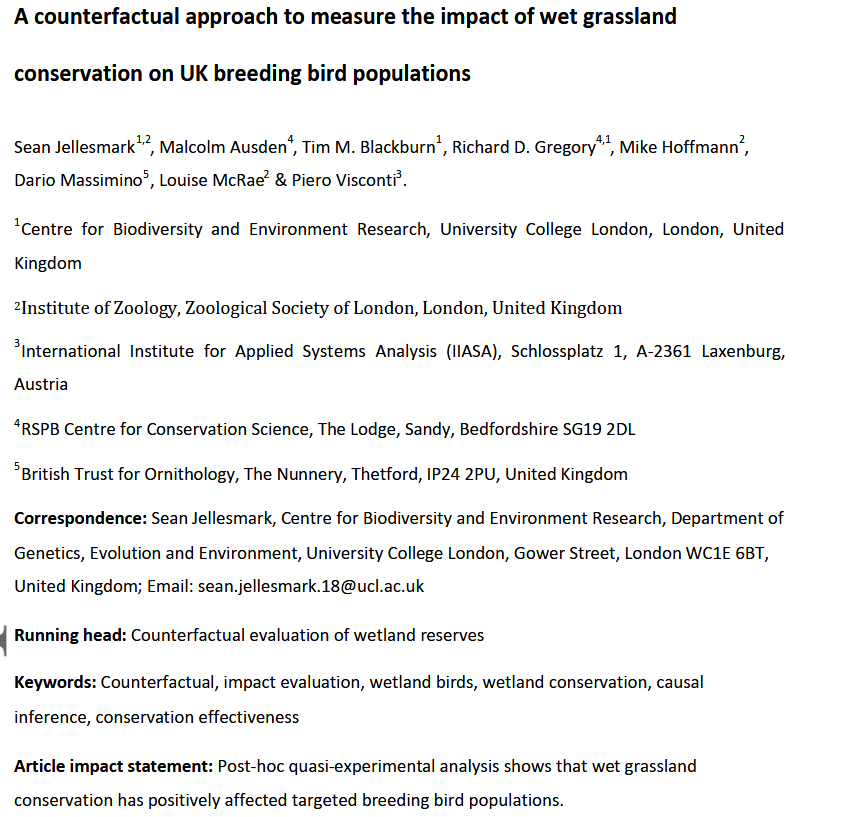
This paper (accepted for publication and avialable online – but may have some last minute changes added to it in terms of copyediting) looks at trends in wetland bird species across RSPB nature reserves and compares them with ‘counterfactuals‘. You’ll have to read the paper to find out what counterfactuals are in general, and which counterfactuals were used here (it was a new word for me) to understand this properly.
However, a picture is worth quite a few words and these pictures;

…indicate that RSPB lowland wet grassland nature reserves (the dark (purple) lines) do ‘better’ over a 20+ year period for Curlew, Lapwing, Redshank and Snipe but don’t do anything much at all for Yellow Wagtail when compared with what might have happened.
Take home message: buying land and managing it for threatened species works well – for some species – if done well.
The paper takes an interesting approach which comes up with a reassuring answer.
[registration_form]
There are lots of words i’ve never heard before, i suppose it’s good to have it there in black and white though, let’s hope it has some influence.
In early 1978, after heavy rains, i assisted the river Rother to breach its banks, flooding a rough field and speedily attracting six Redshank, never known in the area before or since.
Unfortunately , armed only with a spade, i could not maintain it through the spring, but who
knew i was taking a counterfactual approach ?.
I was surprised and my interest peaked when I saw yellow wagtail included as a wet grassland species as the pied wagtails love billiard table grazing here. So I googled Yellow wagtail habitat requirements and got the box with the RSPB list- “Yellow wagtails need an open sward for nesting. They breed on the fringes of wetlands, wet grassland, salt marshes, hay meadows and in some vegetable crops and a number of arable crops, including cereals, potatoes, peas and field beans. Vegetation must be open enough to give the birds easy access to the ground.”
It sounded like they like open land too so with some dread I read the article. I never seem to understand these jargony papers but I hoped there was some english in there.
You say “Take home message:….. works well – for some species – if done well.” I think you don’t need the “for some species” in there.
My message was that the management used does not suit Yellow wagtail. It depends what you do with the wet grassland.. To quote “For example, Ausden et al. (2019) suggested that limiting livestock grazing in spring, which aims to reduce trampling of waders nests, could also reduce habitat suitability for Yellow Wagtail, because they often feed in close association with domestic livestock. While Yellow Wagtail breed in wetland habitats, it has not been a priority species until recently and has not been actively targeted by management“
Interestingly a large proportion of their breeding reserve population of Yws
( 90%, at the start of the period analysed) occurred at a single reserve, the Ouse Washes. I do not know what the grazing was there.
By the way I did not see the graphs on the link. Nor was the referenced map of the reserves visible. But I guess Minsmere featured.
I don’t know what the status of snipe is there now but I was interested in the reported success with Snipe on reserves. In the ‘90s we used to hear up to 3 snipe drumming next door on the Minsmere marshes outside the reserve but they went a good few years (20?) ago now and when I enquired they had gone from a lot of East Anglia as well . I take it this successful management by the RSPB mirrors the environmental schemes which started to come in back then. They limit the time cattle were put onto marshes to but do the schemes have a more detrimental effect on the snipe than beneficial.
It is all so complicated. The marsh next door used to flood with August thunderstorms, in the last say ten years, it foods earlier in the year even May June which cannot help nesting birds.
andrew – the graphs are right at the end of the paper. The map is in the ‘supporting material’.